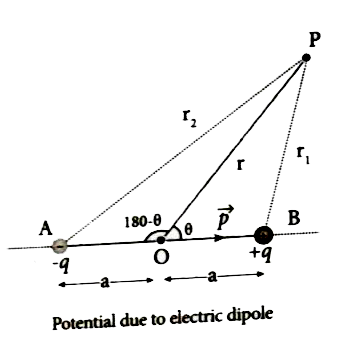Derive an expression for electrostatic potential due to an electric dipole. Solution in Tamil
Electrostatic potential at a point due to an electric dipole: Consider two equal and opposite charges separated by a small distance 2a. The point P is located at a distance r from the midpoint of the dipole . Let θ be the angle between the line OP and dipole axis AB. Let r1 be the distance of point P from +q and r2 be the distance of point P from -q.
Potential at P due to charge +q = 14πε0qr1
Potential at P due to charge −q=−14πε0qr2
Total potential at the point P,
V=14πε0q(1r1−1r2)
Suppose if the point P is far away from the dipole such that r>>a then equation can be expressed in terms of r. By the cosine law for triangle BOP,
r21=r2+a2−2racosθ=r2(1+a2r2−2arcosθ)
m 
Since the point P is very far from dipole then r>>a. As a result the term a2r2 is very small and can be neglected. Therefore
r21=r2(1−2acosθr) (or) r1=r(1−2arcosθ)12(or)
1r1=1r(1−2arcosθ)12
since ar<<1 , we can use binominal theorem and retain the terms up to first order
1r1=1r(1+arcosθ)
Similarly applying the cosine law for triangle AOP
r22=r2+a2−2racos(180−θ) Sincecos(180−θ)=−cosθ we get
r22=r2+a2+2racosθ
Neglecting the term a2r2 ( because r>>a)
r22r2(1+2acosθr) (or) r2=r(1+2acosθr)12
Using Binomial theorem , we get
1r2=1r1−acosθr)
Substituting equations (3) and (2) in equation (1)
V=14πε0q[1r(1+acosθr)−1r(1−a(cosθ)]=q4πε0[1r(1+acosθr−1+acosθr)]
V=14πε02aqr2cosθ
But the electric dipole moment p = 2qa and we get,
V=14πε(pcosθr2)
Now we can write p cos θ=→p.→r where ˆr is the unit vector from the point O to point P . Hence the electric potential at a point P due to an electric dipole is given by
V=14πε0→.→rr2(r>>a)
Equation ( 4) is valid for distances very large compared to the size of the dipole . But for a point dipole the equation ( 4) is valid for any distance.
Special cases:
Case (i) If the point P lies on the axial line of the dipole on the side of +q then theta =0 . Then the electric potential becomes
V=14πε0Pr2
Case (ii) IF the point P lies on the axial line of the dipole on the side of -q then θ180∘ then V=14πε0pr2
Case (iii) If the point P lies on the equatorial line of the dipole then θ=90∘ . Hence V= 0 .
Topper's Solved these Questions
- ELECTROSTATICS Book:FULL MARKSChapter:ELECTROSTATICS Exercise:EXERCISES
Explore 15 Videos
- ELECTROSTATICS Book:FULL MARKSChapter:ELECTROSTATICS Exercise:ADDITIONAL QUESTIONS SOLVED ( Multiple choice questions : )
Explore 57 Videos
- ELECTROSTATICS Book:FULL MARKSChapter:ELECTROSTATICS Exercise:Textual Evaluation Solved (II. Short Answer Questions : )
Explore 21 Videos
- DUAL NATURE OF RADIATION AND MATTERBook:FULL MARKSChapter:DUAL NATURE OF RADIATION AND MATTERExercise:ADDITIONAL QUESTIONS -( ADDITIONAL NUMERICAL PROBLEMS : )
Explore 10 Videos
- MAGNETISM AND MAGNETIC EFFECTS OF ELECTRIC CURRENT Book:FULL MARKSChapter:MAGNETISM AND MAGNETIC EFFECTS OF ELECTRIC CURRENT Exercise:ADDITIONAL QUESTIONS SOLVED - NUMERICAL PROBLEMS :
Explore 4 Videos
Similar Questions
When two objects are rubbed with each other approximately a charge of 50 nC can be produced in each object . Calculate the number of electrons that must be transferred to produce this charge.
View SolutionWhen a slide body is negatively charged by friction, it means that the body has
View SolutionWhat is meant by quantisation of charges ?
View SolutionIf a light of wavelength 4950 Å is viewed as a continuous flow of photons, what is the energy of each photon in eV ? (Given h=6.6×10−34Js, c =3×108ms−1)
View SolutionThe radius of the first orbit of hydrogen atom is 0.5 Å. The electron moves is an orbit with a uniform speed of 2.2×106ms−1. What is the magnetic field produced at the centre of the uncleus due to the mation of this electron ? Use μ0=4π×10−7Hm−1 and electric charge =1.6×10−19 C
View Solutionकिसी विद्युत् द्विध्रुव के कारण किसी बिन्दु पर विद्युत् विभव होता है :
View SolutionDefine electric potential. Derive and expression for the electric potential due to an electric dipole and hence the electric potential at a point (a) the axial line of electric dipole (b) on the equatorial line of electric dipole.
View SolutionDerive an expression for electrostatic potential due to an electric dipole.
View SolutionWhat is an electric dipole and electric dipole moment? Derive an expression for electric potential at any point due to an electric dipole. Also discuss the special cases.
View SolutionDerive an expression for electrostatic potential due to a point charge .
View SolutionDerive an expression for electrostatic potential energy of the dipole in a uniform electric field .
View SolutionDerive an expression for electrostatic potential due to an electric dipole.
View SolutionElectrostatic potential due to an electric dipole
View SolutionElectrostatic potential due to an electric dipole
View Solution(i) Derive the expression for the specific for the electric potential due to an electric dipole at a point on its axial line.
(ii) Depiet the equivpotential surfaces due to an electric dipole.
View Solution
